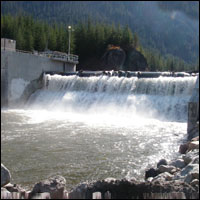India is endowed with significant hydroelectric potential and ranks fifth in the world in terms of usable potential, but surprisingly, around 67 percent of the country’s hydroelectric potential remains untapped.
As per the latest available data, India’s installed hydropower capacity totals 36 GW and another 13 GW is under construction. The total hydropower potential of 148 GW will be able to meet a demand of 84 GW at 60 percent load factor.
In the north eastern region of the country, over 93 percent of the total hydroelectric potential is yet to be tapped, primarily in parts of the Brahmaputra river basin. More than 65 percent of the potential has been harnessed in the southern and western regions.
Despite the growing demand for electricity, and the consequent gap in the demand and supply of electricity, the share of hydropower in India’s energy mix has been declining since 1966, coming down to 17 percent from 46 percent.
In the 11th Five Year Plan, the target for hydropower capacity addition was placed at 16.5 GW, almost half of the total installed capacity then. However, the achievement, at around 5,400 MW, was well short of the target.
In FY 2013-14, the country experienced a peak deficit of 5.2 percent and energy deficit of 4.2 percent. Considering an energy elasticity of 0.8, around 7 percent annual growth in electricity supply is required to sustain a GDP growth of 8.5 percent per annum over the next few years.
Around the world, climate change and other negative effects of using fossil fuels for power generation along with growing concerns over energy security are driving the expansion of hydropower.
A recently released knowledge paper on the hydropower sector in India by the Federation of Indian Chambers of Commerce and Industry and PwC attributed the declining share of hydropower in the country’s energy mix to the issues that plague implementation of the government’s policy initiatives for prioritizing hydropower development.
Titled ‘Hydropower in India: Key enablers for a better tomorrow’, the paper said various factors such as environmental concerns, resettlement and rehabilitation issues, land acquisition hurdles, delays in clearances and capability of developers had contributed to the slow pace of hydropower development in the past.
“These issues have been compounded as hydropower development has largely remained under the ambit of state governments (water being a state-specific subject) with varying policies (e.g. upfront premium, royalty power, land acquisition policy, etc.) adopted by the states,” the paper said.
The hydropower sector in the country was opened for private sector participation in 1991 to accelerate growth and bridge the gap between actual and planned capacity addition. Between 1991 and 2012, the private sector contributed to about 11.5 percent of hydropower capacity addition. So far, about 2,700 MW has been commissioned through the private route which constitutes less than 7 percent of total installed hydropower capacity.
“Though private participation in the hydropower sector has gained momentum in the recent past, it still faces impediments in the execution of projects across various stages of the project implementation cycle. The central and state governments need to create an enabling investment climate for increasing private participation by addressing issues related to safeguards, land acquisition, evacuation, law and order problems, technical challenges and non-appreciation of the risks involved in project development,” the paper said.
The challenges facing the hydropower sector in the country relate to planning for hydropower development, land acquisition, safeguard issues (rehabilitation of project affected people, deforestation, protection of flora, fauna, forests and wildlife, disaster potential in the event of earthquakes, reservoir induced seismicity, surplusing of reservoir etc), financing due to high capital costs and long construction period, technical difficulties and enabling infrastructure.
The FICCI-PwC knowledge paper lays down a road map with the objective of addressing the various challenges that confront the sector. It takes into account five critical factors for responsible hydropower development providing key enablers for each of them. The factors considered in the paper include governance framework with key enablers being inter-governmental coordination, integrated planning and a supportive institutional structure, facilitation of investments and financing with key enablers being streamlining of clearance processes, provisions for associated infrastructure, fiscal incentives and innovative financial products to help raise long term and cheap financing, facilitation of market development with key enablers being incentives for hydropower purchase, incentivizing hydropower for its quick response and black start characteristics through introduction of differential tariff structures and a market for ancillary services, benefit-sharing mechanism with key enablers being focus on responsible development, public-private-people participation and benefit sharing with PAPs, and technical capacity development in terms of introduction of state-of-the-art investigation and construction techniques











